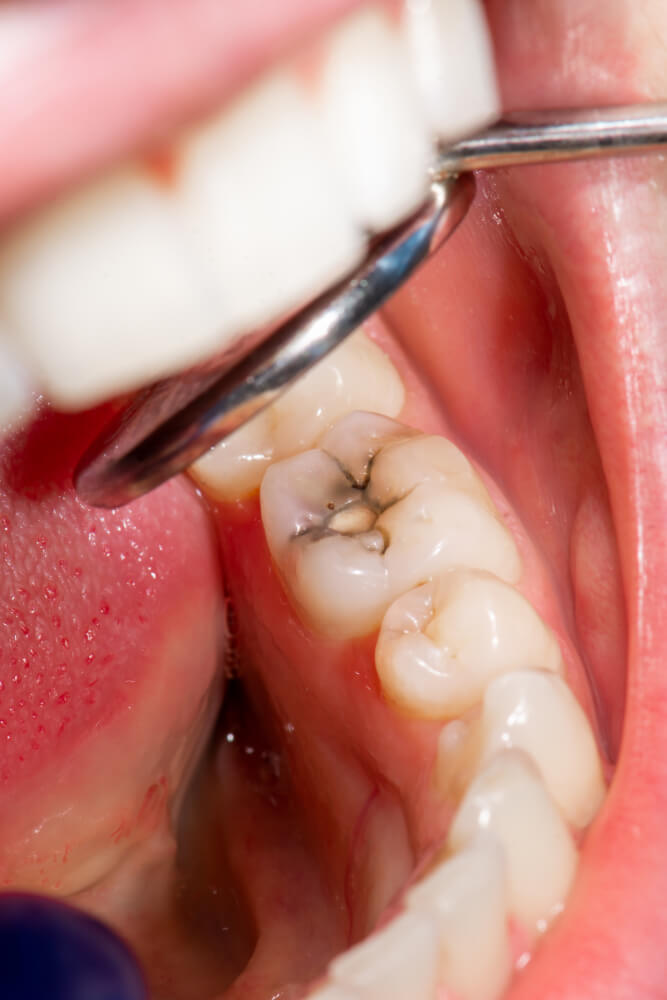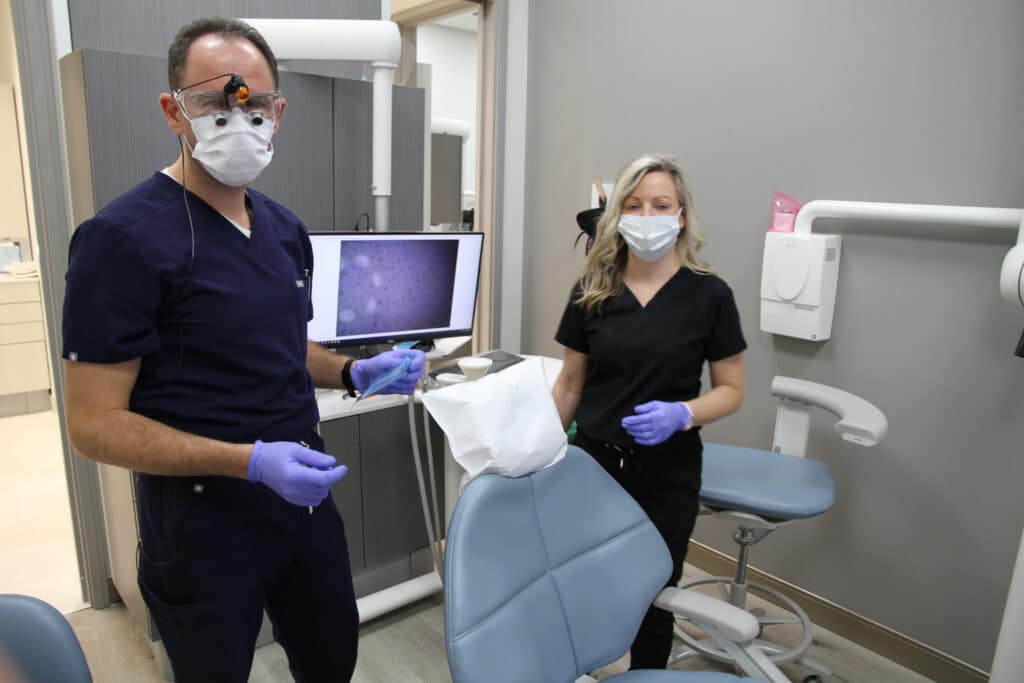White Tooth Fillings in Newmarket
White Tooth fillings (“composite resin restorations”) act to replace decayed or broken tooth structure and restore its soundness. Dental decay (“cavity”) forms when bacteria invade the tooth structure and demineralize it, making it soft. During a routine dental checkup, the dentist will examine your teeth for the presence of decay. Not all decay requires treatment. Some may be observed if it is confined to the outer-most layer of the tooth or if it is arrested (i.e. not growing over time). The dentist will evaluate many factors in determining whether or not a white filling is required. These factors include such things as your dental history, susceptibility to decay, oral home care, medical conditions and others.
We use multiple modalities to locate and visualize tooth decay including radiographs (x-ray images) and intraoral images. We will share the information with you so you can see for yourself why a white filling in your tooth may be necessary.

Dental Restoration with White Tooth Fillings
White tooth fillings have become the mainstay option for dental restorations due to their enhanced strength and aesthetic appeal, making them suitable for both anterior and posterior dentition in kids and adults. They have come to replace the silver metallic amalgam fillings which were in widespread use 40+ years ago.
White Tooth Fillings have several advantages over metallic amalgam fillings:
Increased Esthetics
White tooth filling material comes in a myriad of shades and the dentist can tailor the shade to best match that of your existing teeth. In some cases, this is accomplished by mixing multiple filling shades together and requires high of skill. White tooth fillings also do not leach gray material out like amalgam fillings often did resulting in highly esthetic results where one cannot easily see the filling in a tooth. This is a stark contrast to the gray metallic colour of amalgam filled teeth which stands out tremendously and is not esthetic.
Bonded Strength
White tooth fillings are bonded or glued to the tooth using a bonding agent whereas metallic amalgam fillings were mostly wedged into cutouts prepared in teeth. As such, once bonded, the composite resin white tooth filling becomes part of the tooth and strengthens the cusps between which it sits rather than weakening them. This makes the tooth more resistant to fractures. Because of the bonding involved, white tooth fillings can be placed in other areas of teeth and not only on their chewing surfaces. It is possible to cover the lip side of teeth and manipulate the shape and shade of teeth to make them more esthetic in a procedure called “direct bonding”. Direct bonding was impossible with amalgam metal fillings
Minimally Invasive Preparations
Since white tooth fillings are bonded, they do not rely on cutouts in the tooth being in a particular shape to retain them inside the tooth like amalgam metal fillings require. This allows the dentist to prepare smaller cutouts in the tooth than they would otherwise be required to cut if using amalgam metal. Less tooth structure removal means increased tooth strength and survivability.
Increased Safety and Biocompatibility
Many patients have metal hypersensitivity and cannot tolerate contact with metals including metal amalgam. Furthermore, dental amalgam contains mercury and silver which are heavy metals that many people prefer simply not to have in their mouths because of their risk of leaching out over time.
Choose Excellence in Dental Care
At Leslie Family Dental Newmarket, our goal is to partner with you in maintaining optimal oral health – our commitment to excellence can be seen through all our dental solutions, including placing of white tooth fillings, as a testament to the precision and aesthetic quality of dentistry we deliver.
Preserve your smile and oral health with Leslie Family Dental Newmarket.
Book your white tooth filling appointment today at (289) 453-0606.

Frequently Asked Questions
- Toothache
- Sensitivity to sweets, hot or cold
- Visible cavity (a hole) in a tooth
- The existing filling is cracked
- Other Visible Signs: Chipped or cracked teeth, torn/shredded dental floss when cleaning them or food particles getting lodged between teeth.
Dental fillings come in various materials, from gold and silver amalgam fillings to tooth-colored white fillings such as porcelain, composite, or glass ionomer cement.
At Leslie Family Dental, the answer is ALL THE TIME. We exclusively use white tooth fillings. Our office does not place metallic fillings.
The choice of white filling material depends on factors such as:
Composites: Ideal for concealing fillings and adding aesthetic appeal, composite resin fillings may take more time in the dental chair to install.
Ceramic: Made of porcelain, these tiles resist staining while retaining color for extended use.
Glass Ionomer: It uses acrylic and specific glass compounds for cavities below the gumline in children or for use when treating cavities below them; it releases fluoride for tooth strengthening.
White fillings tend to last between five and 15 years, depending on their material; composite fillings last an estimated five years, while ceramic or glass ionomer cement solutions may need replacement after 10 to 15 years.
White fillings like composite resin or porcelain offer aesthetic versatility and stability when exposed to temperature variations while being stronger than amalgam fillings with less drilling involved.
We get asked this question a lot. The answer is “It depends.”
Generally speaking, if there is nothing wrong with your metal fillings, it is probably best to leave them alone. If it ain’t broke, don’t fix it.
However, if the metal fillings are cracked, chipped, worn, leaky or have decay around them, you should definitely consider replacing them. If you are contemplating getting a crown over a tooth with an old metallic filling, you should consider replacing it first with a composite resin filling before preparing the tooth for a crown.
If the esthetics are very important to you and you are specifically looking to improve them then you can consider replacing the existing amalgam fillings that you may have. However, you should always consult with the dentist regarding the possible risks associated with switching your metal fillings to white tooth fillings. In some cases, it may be best to leave the metal filling alone because the area where the filling needs to be placed may prevent the placement of a white tooth filling due to moisture presence.
The most common risk is post-operative thermal sensitivity (cold sensitivity) which may linger for a few weeks to a few months. Eventually it usually goes away completely.
If your existing metal filling is very deep and close to the nerve of the tooth, there may also be risk of the nerve not surviving the procedure and the tooth needing a root canal treatment as a result. It may not always be possible to predict the outcome accurately when it comes to replacing very deep metal fillings. In many cases, deep metal fillings get replaced without any issues. Having a recent dental x-ray image of the subject tooth is important in assessing the situation and the dentist may recommend taking one prior to such a procedure. We encourage you to always have a healthy dialogue with the dentist about this if you insist on a replacement of a deep metal filling for esthetic purposes only. If the metal filling is defective and needs to be replaced, it is a risk that you will have to take and the dentist will mention it before treating you.
Over time, Composite fillings may become discolored at their edges from substances like coffee, red wine, black tea or tobacco. This happens because of wear and deterioration of the composite material over time. Sometimes the stain may be polished off with dental polishing burs. However, if it does not polish off, replacement of the filling with a new filling should be considered.
Composite resin fillings involve anesthetizing the area, removing the decay or old filling, etching of the preparation surface with acidic compound, rinsing off, drying the area and isolating it from saliva/blood, applying bonding agent, air drying, layering the composite material, and incrementally light curing with the composite special UV lighting. Once set, the composite resin filling is fully hardened and ready for use immediately.
You can eat and drink immediately since the filling is fully set by the time the procedure is done. Having said this, when it comes to eating, you must be careful when chewing because the anesthetic (if administered to you) may still be very active and you may not have a good sensation of your tongue, lip or cheek. Therefore, you may want to be careful when chewing to avoid possible bite trauma. It is always a safe bet to wait until the anesthetic wears out before eating but if you must eat immediately, you can do so with caution. When it comes to drinking fluids, you should be careful with hot drinks so as to avoid getting a burn if still anesthetized.
Maintain your white fillings by brushing and flossing regularly using a soft toothbrush, using nonabrasive toothpaste, reducing exposure to staining substances, using alcohol-containing mouthwashes sparingly, refraining from noneating activities using teeth, scheduling regular check-ins with your dentist and scheduling regular dental checkups.
The setting time for dental fillings can vary based on the chosen filling material. Our composite white fillings typically harden immediately after the dental procedure.
Newmarket Dentist - Visit Us Today
book your appointment today
We at Leslie Family Dental are committed to providing the finest quality dental care in a safe and comfortable environment. Our team is incredibly passionate about their work, and we genuinely care for our patients.
Contact UsWe are always accepting new patients
